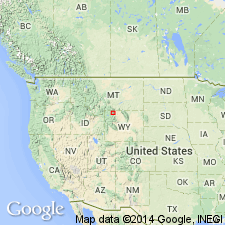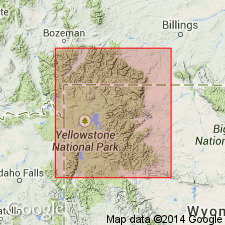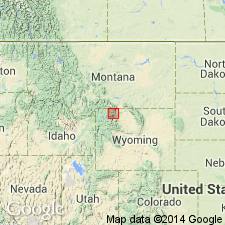
- Usage in publication:
-
- Cathedral Cliffs Formation*
- Modifications:
-
- Named
- Dominant lithology:
-
- Tuff
- AAPG geologic province:
-
- Yellowstone province
- Bighorn basin
Summary:
Cathedral Cliffs Formation. Name proposed for rocks in Clarks Fork area that have long been known by informal name "early acid breccia." Composed of tuffs, with lesser amounts of volcanic sedimentary rocks and breccias. Thickness ranges from less than 100 feet to about 1,500 feet but more commonly 500 to 900 feet. [Present in northwestern Wyoming and southwestern Montana; exposures are scattered patches east of Yellowstone National Park.] At type locality overlies Madison Limestone. Underlain by rocks ranging from Precambrian to late early Eocene or early middle Eocene and unconformably overlain by "early basic breccia" of middle Eocene age. [Fossils.] Age is considered early Eocene. (Cathedral Cliffs Formation adopted by the USGS.)
Type locality: at west end of north face of Cathedral Cliffs, a prominent feature on south side of valley of Clarks Fork of Yellowstone River in southeastern part of Beartooth Butte quadrangle, [in T. 56 N., R. 106 W., Park Co., northwestern WY].
[Misprint: on p. 129, US geologic names lexicon (USGS Bull. 1350), should be "early acid breccia," not "early and breccia."]
Source: US geologic names lexicon (USGS Bull. 1350, p. 129); supplemental information from GNU records (USGS DDS-6; Denver GNULEX).

- Usage in publication:
-
- Cathedral Cliffs Formation*
- Modifications:
-
- Revised
- AAPG geologic province:
-
- Yellowstone province
Summary:
Pg. C10-C11 (fig. 8), C21. Cathedral Cliffs Formation of Washburn Group of Absaroka Volcanic Supergroup. Assigned to Washburn Group (new) of Absaroka Volcanic Supergroup (new). Consists of light-colored volcaniclastic rocks. Interfingers with and underlies the dark-colored volcaniclastic rocks of the Lamar River Formation (new) of Washburn Group. Fossils. Age is considered early Eocene (Wasatchian NALMA). (Cathedral Cliffs Formation of Washburn Group of Absaroka Volcanic Supergroup adopted by the USGS.)
Source: Publication; Changes in stratigraphic nomenclature, 1972 (USGS Bull. 1394-A, p. A8-A9).

- Usage in publication:
-
- Cathedral Cliffs Formation
- Modifications:
-
- [Not used]
Summary:
[Established formal nomenclature is not used in Park Co, WY.] "Due to the fact that the formal nomenclature of volcanic rocks of the Northern Absaroka Mountains has proven problematical in field mapping of the detachment area (Fig 2), and because the names "Wapiti Formation" and "Cathedral Cliffs Formation" both connote temporal relationships with the Heart Mountain faulting that are unresolved, the formal nomenclature was abandoned in this study." [Choice of word "abandoned" is unfortunate. Author should simply have said that he was "not using" the established formal nomenclature in his study area.]
Source: GNU records (USGS DDS-6; Denver GNULEX).
For more information, please contact Nancy Stamm, Geologic Names Committee Secretary.
Asterisk (*) indicates published by U.S. Geological Survey authors.
"No current usage" (†) implies that a name has been abandoned or has fallen into disuse. Former usage and, if known, replacement name given in parentheses ( ).
Slash (/) indicates name conflicts with nomenclatural guidelines (CSN, 1933; ACSN, 1961, 1970; NACSN, 1983, 2005, 2021). May be explained within brackets ([ ]).

